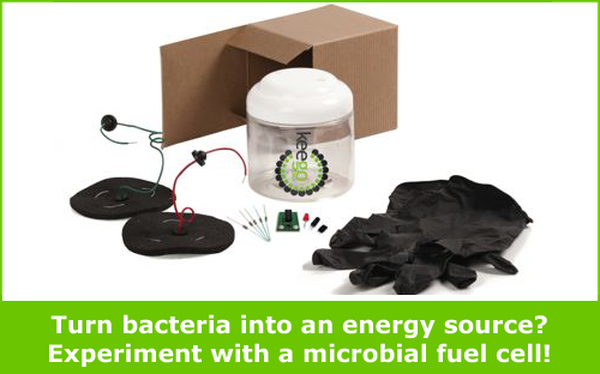Microbial Fuel Cells: On the Hunt for Renewable Energy
Renewable energy is hiding in places you might not think to look! For a glimpse into the future of power generation, experiment with a microbial fuel cell.
By Kim Mullin
Ask anyone about sources of renewable energy, and they are likely to mention solar power, wind power, or perhaps even geothermal power. Hydro (or water) power, too, may come up, but when you talk about water as a renewable energy source, you probably are talking about energy harnessed from falling or running water.
But what about the dirty water running through our underground sewage pipes? What if a wastewater treatment plant could power itself with the very water that it is supposed to clean?
Beyond Sun and Wind
The idea of producing energy from dirty water isn't as far-fetched as it sounds. Thanks to something called a microbial fuel cell, extracting energy from microbes such as bacteria is possible. Why? Because some types of bacteria produce electrons when they feed on the nutrients found in places such as dirty water or soil—both of which are easy to find! In a microbial fuel cell, these electrons can be captured by electrodes and used as a power source.
You may be wondering what sorts of "nutrients" can be found in dirty water and soil. After all, humans depend on fresh fruits, vegetables, and proteins for the vitamins and minerals that help us thrive. However, some types of bacteria can live on compounds that our bodies treat as waste. For example, the urine that we flush down the toilet is full of nitrogen, and nitrogen is part of a healthy diet for some types of bacteria.
Harnessing the Power of Bacteria
Scientists discovered electricity-producing bacteria in the early 1900s, but recent interest in renewable energy has increased research in this area. To make microbial fuel cells a viable renewable power source, one important question that scientists must answer is how to best maximize the amount of electricity that they can produce.
With the Science Buddies Project Ideas below, you can be a renewable energy scientist. Try any of these projects to get started:
- Powered by Pee: Using Urine in a Microbial Fuel Cell: Can you increase the electrical output of a microbial fuel cell by increasing the level of nutrients available for the bacteria to digest? Is it possible to overdo it? Using the microbial fuel cell kit and urine as a source of nitrogen, explore how to optimize power generation.
- Spice Up the Power of a Microbial Fuel Cell with a Dash of Salt: One way to increase electrical output is to make it easier for electrons to flow. Adding salt will do the trick, but is there a point at which it is counterproductive to add more salt? Use the microbial fuel cell kit to experiment and find out!
- Waste Not, Want Not: Use a Microbial Fuel Cell to Create Electricity from Waste: Love to build? This experiment is for you! Learn step-by-step how to build a microbial fuel cell from scratch and then discover how much electricity you can harvest from bacteria living in benthic mud.
Microbial Fuel Cells—Building Your Own Alternative Energy Experiment
After assembling your microbial fuel cell using a kit, connect the fuel cell's hacker board. Within 3-10 days, the hacker board should begin blinking, though you will start taking measurements right away!
In addition to the microbial fuel cell projects listed, students interested in alternative energy projects might explore:
- Go Green by Growing Green: How to Extract Energy from Grass
- Make the Wind Work for You!
- Wily Waves: Build an Oscillating Water Column to Extract Energy from Ocean Waves
- Put Your Water to Work: Using Hydropower to Lift a Load
- Leaky Clues to Dam Design: How Reservoir Height Affects Hydroelectric Power Production
Powering the Future
While you shouldn't expect to be recharging your cell phone with a microbial fuel cell next year, it is possible that one day this technology will be as common as solar panels. Will you be among the scientists who explore innovative ways to keep up with our energy needs?
Categories:
You Might Also Enjoy These Related Posts:
- 10+ Robotics Projects with the BlueBot Kit
- 15 STEM Gifts & Science Kits You'll Feel Good About Giving
- 12 Science Kits for Summer Science Experiments and Discovery
- Build a Water Sensor Circuit for the Tree
- Science Project Kits - Our top 10 list!
- Explore Coding and Electronics with Raspberry Pi
- Three new Science Kits for K-12 STEM
- Shoebox STEM: A 4-H Success Story










